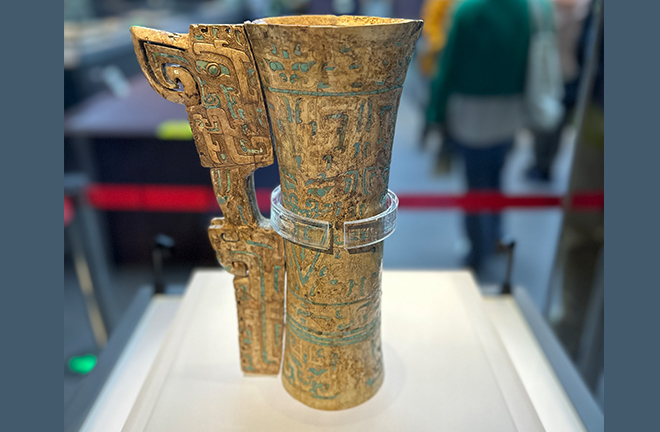Ruins of Yin testify to China’s past

An ivory cup unearthed from Fuhao Tomb at the Ruins of Yin Photo: Ren Guanhong/CSST
Among the most notable contributions to the study of ancient Chinese civilization is the archaeological excavation of the Yin Ruins in Anyang, Henan, which commenced in 1928.
Archaeological significance
Initially, the focus of the Yin Ruins archaeology was to tackle key academic inquiries, primarily concerning the chronology and characteristics of ancient Chinese civilization. Prior to its excavation, numerous scholars, both domestic and international, believed that Chinese history began in 841 BCE (the year when continuous historical records began). With discoveries such as inscribed oracle bones, the Yin Ruins provided evidence of the existence of the brilliant Shang civilization [approximately from the 16th century to the 11th century BCE].
The archaeological work at the Yin Ruins has served as the most important reference point in the chronological framework of Chinese archaeology. The discoveries of oracle bones, bronzes, tombs of various sizes, workshops, and other buildings spurred further contemplation among experts. Realizing the advanced nature of such a civilization implied a lengthy period of evolution, prompting researchers to extend their studies into early Shang remains. This led to archaeological explorations of the Xia sites. Meanwhile, some researchers shifted their attention to the successors of the Shang civilization, leading to archaeological work on the Zhou and later dynasties. These findings, now widely acknowledged as common knowledge, might have remained hidden without the discoveries at the Yin Ruins.
In 1937, archaeological work at the Yin Ruins ceased after the outbreak of the War of Resistance Against Japanese Aggression. Despite this, archaeologists relocated specimens and other materials to safer areas, where they continued their research under challenging conditions and achieved significant results. Particularly notable were the contributions of a group of scholars who sorted and studied oracle bone inscriptions, represented by Guo Moruo, Dong Zuobin, and Hu Houxuan. Meanwhile, experts who had participated in the excavation of the Yin Ruins branched out to continue archaeological work in the rear areas, advancing archaeology across the country. In the 1950s and 1960s, archaeological reports on the Yin Ruins were regularly published in prestigious academic journals such as Archaeology. The major archaeological discoveries in the mid-1970s, represented by the Fuhao Tomb and the oracle bones found south of the Xiaotun site, put the Yin Ruins in the spotlight both at home and abroad.
Home-grown talents
The Yin Ruins also cultivated many Chinese archaeological talents. Five archaeologists who participated in the excavations of the Yin Ruins in the 1930s rose to become national academicians. After the 1950s, Guo Baojun, Zheng Zhenxiang, Liu Yiman, Yang Xizhang, Yang Baocheng, and other scholars who later emerged as prominent archaeologists essentially “grew up” at the Yin Ruins.
Many new archaeological methods and technologies were pioneered at the Yin Ruins. As far as I know, the Yin Ruins was one of the sites where modern approaches were first applied, including radiocarbon dating, archaeological geophysical surveys, environmental archaeology, archaeozoology, physical anthropology, metallurgical archaeology, and interdisciplinary cooperation. Despite its status as an old institution, archaeological research at the Yin Ruins remains ever fresh in terms of its quick adoption of new methods and technologies.
The Yin Ruins have a prominent status in Chinese archaeology and in the exploration of the origins and evolution of Chinese civilization. It also plays a unique role in the history of Chinese field archaeology, having long been regarded as a sacred place by Chinese archaeologists. Those who have dedicated decades to working there have endured challenging living conditions while educating and training young archaeologists. Their commitment to careers, coupled with a continuous innovation in their knowledge, has led to significant successes. The story of the Yin Ruins is not just a portrayal of Chinese archaeologists but also a microcosm of Chinese archaeology itself.
Gao Dalun is a professor from the Southern University of Science and Technology.
Edited by REN GUANHONG
